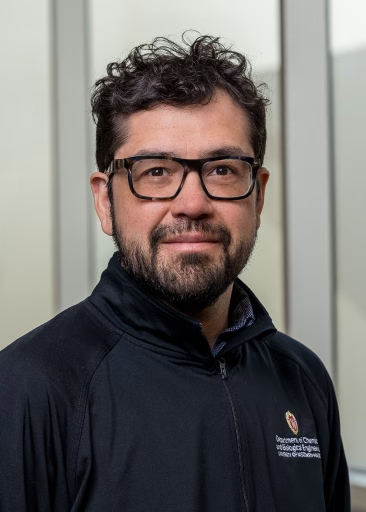When Zack Harmer’s advisor and lab leader, Biomedical Engineering Associate Professor Megan McClean, suggested he explore a potential collaboration with Chemical Engineering Professor Victor Zavala’s computational group, the University of Wisconsin-Madison PhD student didn’t need to look far.
David Cole, Harmer’s roommate for three years, was a PhD student in Zavala’s lab, which has a litany of experience applying computational techniques to engineering challenges.
The initial conversations between the students eventually led to a project that brought together the McClean lab’s platform for high-throughput testing of optogenetic systems with the Zavala group’s machine learning toolkit. Together, the team created a framework for designing advanced synthetic biology systems that could be useful for generating biotherapeutics or other bioproducts.
The UW-Madison researchers detail their approach in a paper in the journal ACS Synthetic Biology.
In optogenetic systems, scientists manipulate biological processes through light-responsive proteins. Many of those proteins respond to blue light, which presents a challenge when trying to design more complex systems that allow for independent control over multiple processes. One potential solution is to take advantage of different dynamics of blue light; for example, pulsed light might activate one such function, while sustained light turns on another.
“How can we just use one wavelength of light to independently control multiple different biological outcomes?” says Harmer (PhDCMB ’23), who’s now a synthetic biology scientist at a California-based biotechnology company.
“Finding those sweet spots is hard,” adds McClean.
Harmer and McClean had previously developed a system named Lustro for high-throughput testing to accelerate the design and optimization of optogenetic systems, technology for which they’re pursuing a patent through the Wisconsin Alumni Research Foundation. By teaming with Zavala, they harvested the trove of data generated by Lustro.
 Victor Zavala
Victor Zavala
“All of a sudden you have access to all of this data, to test all of these different conditions, and we were able to apply more sophisticated techniques than what I originally envisioned,” says Zavala, whose research group develops computational techniques for optimization and control. “We were able to use machine learning approaches to construct this model directly from data, trying to find optimal conditions and trying to recommend experiments in a closed-loop manner. That was transformational.”
Zavala’s group developed neural networks that, given a range of experimental conditions (proteins involved, light inputs), could predict outcomes while also quantifying the level of uncertainty in those predictions. Jaron Thompson, a PhD student co-advised by Zavala and Ophelia Venturelli, associate professor in the Department of Biochemistry (and an affiliate faculty member in the Department of Chemical and Biological Engineering), primarily developed the machine learning tools.
“Experiments are not free, in either reagent cost or time,” says McClean. “I think what’s particularly nice about the model is, in addition to making predictions about specific behaviors of the system, it can tell you where to do experiments and where it’s most informative to do experiments. That’s really powerful.”
McClean and Zavala are already exploring additional opportunities to apply similar approaches to more complex biological systems, as well as developing and leveraging more sophisticated modeling techniques.
“Wisconsin has a pretty unique environment for fostering these types of collaborations,” says Zavala. “I think the College of Engineering is very cohesive. It’s easy to start these types of collaborations, and people are very friendly. It’s just really a pleasure to collaborate with people around here across different departments.”
Victor Zavala is the Baldovin-DaPra Professor in the Department of Chemical and Biological Engineering. The research was supported by grants from the National Institutes of Health (grants R35GM128873, R01EB030340 and R35GM124774), the Army Research Office (grant W911NF1910269) the National Science Foundation (grants CBET 2315963 and MCB 2045493).
Top photo caption: PhD student Zack Harmer, right, and Associate Professor Megan McClean have developed a technique for greatly accelerating the design and optimization of optogenetic systems. Photo by: Tom Ziemer.